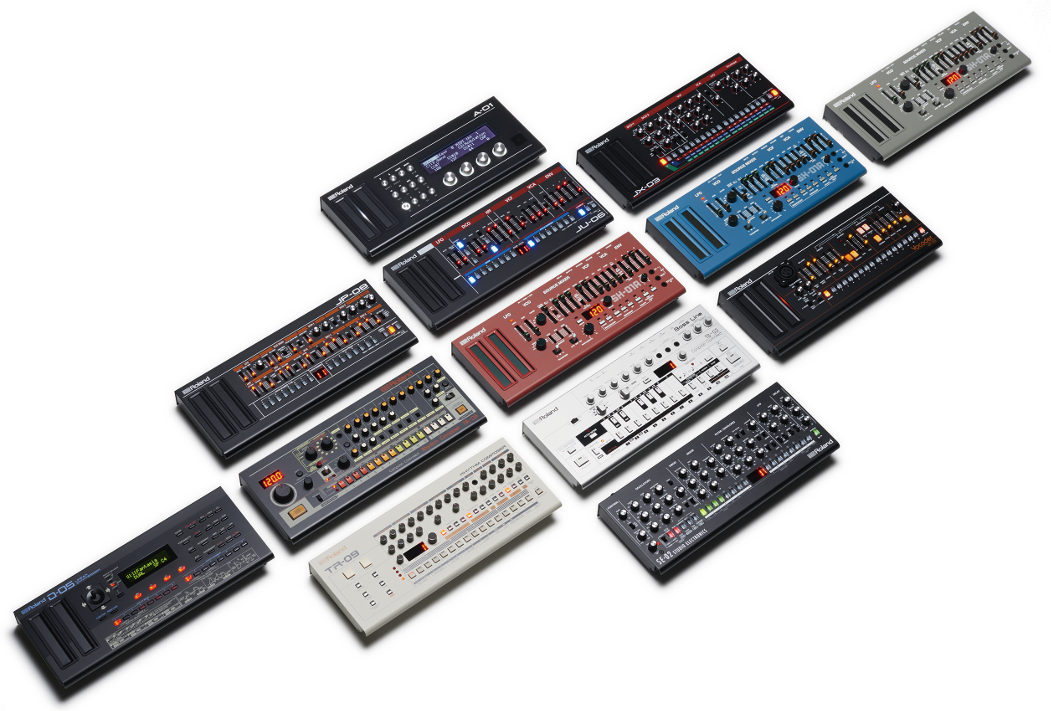Roland Boutique is a series of small form factor electronic music instruments. The line debuted in 2015 with recreations of three iconic Roland 1980s synths. I got the JP-08 which I wrote about here. Since then I’ve been watching the series grow with interest.
By now, the Boutique line includes nine products recreating Roland’s back catalog: Five subtractive synths (JP-08, JU-06, JX-03, TB-03, SH-01A), the VP-03 vocoder, the TR-08 and TR-09 drum machines, and finally the D-05 “linear synthesizer” mixing sampling and synthesis.

In 2017, Roland ventured outside their own history. Teaming up with Studio Electronics, they released the Minimoog-inspired analog monosynth SE-02. Having started down this path, they might make an FM (frequency modulation) synth. Missing from the lineup is also perhaps a sampler/sample player/sample mangler?
That would at least match miniatures produced by other manufacturers in the last few years. The very small and affordable Korg Volca series has the straightforwardly named Beats, Bass, Keys, Sample, and FM. The first four predated the original Boutique trio by 1-2 years, while the FM was released in 2016.
Swedish manufacturer Elektron also recently went small with the less toylike — and less affordable — Digitakt sampler and Digitone FM-synth, with the latter being announced just one month ago.
The 2015 Yamaha Reface series also has CS, DX, YC, and CP, doing synth, FM, electric organ, and electric piano, respectively. And this leads me toward what I would most like to see in the Roland Boutique series.
Give Me a Piano!
When you think of a digital piano, you are more likely to think of 88 weighted keys than 25 non-weighted “synth action” minikeys. But one of the advantages of the Boutiques is that they can both slot into the K-25m keyboard module and perform as a sound module/desktop synth.
I would love to have a Roland Boutique piano with high-quality, natural, acoustic piano sounds as well as high-quality electric pianos, organs, strings, etc. I guess the model number would be in the form of FP-0x or RD-0x. I would use such a Boutique piano module both as a sound module plugged into a MIDI keyboard, and in the sofa as a plaything and/or compositional tool with the K-25m keyboard attached.
The D-05 unfortunately does not fill this role. When the D-50 was launched in 1987 it certainly came closer than any analog synth to sounding like acoustic instruments, but that doesn’t mean it could actually pass for one. I went to my local music store to try out the D-05, and while it does have a dozen patches with “piano” in their name, none of them sound like an acoustic piano. It can do electric pianos and organs, but overall I think the D-50/D-05 has a certain 80s/90s “lo-fi” sound. It excels at some things, but not acoustic piano.
The Panel
Some of the Boutiques have too many buttons crammed into the limited space on the panel. This includes the JP-08, and judging from pictures, also the TR-08, TR-09 and SE-02. Some have a more reasonable amount, such as the JU-06, SH-01A, and VP-03. The D-05 doesn’t have too many buttons per se, but it faithfully recreates the dreary menu diving experience of the “digital age” (to achieve more hands-on programming of the D-50/D-550/D-05, you need the enormous PG-1000 programmer). But, digital pianos typically do not have a lot of buttons. So what do I want on the Boutique piano panel?
I can think of a lot!
- Better speaker(s), perhaps even front facing
- Dedicated octave up/down buttons
- A good pitch/modulation stick (yes, electric organs can pitch bend)
- Effects! Reverb, Leslie, Overdrive, Chorus, you name it.
- Loop machine
- Tape recorder
- Sequencer
- Arpeggiator
- Chord memory
- Scale/chord library (like a KordBot?)
Finally, such a module shouldn’t be expensive. Unless it would have several of the above features, it should be closer to 150 €/$ than to 400 €/$. It’s a ripoff that the K-25m keyboard is already 100 €/$.